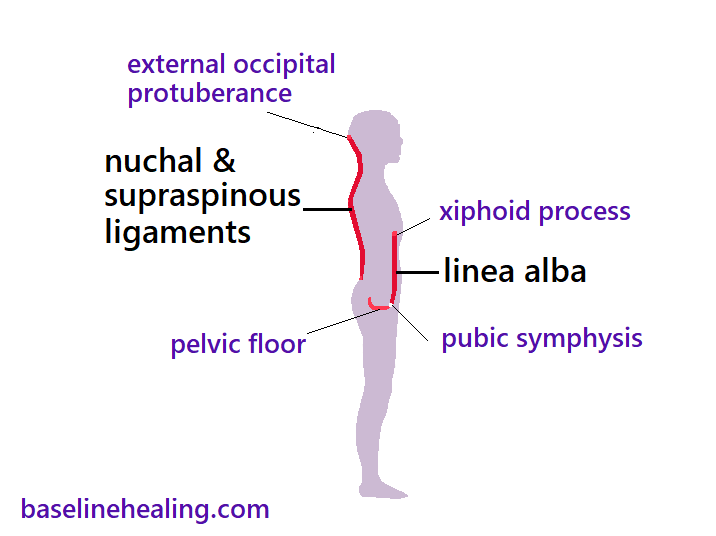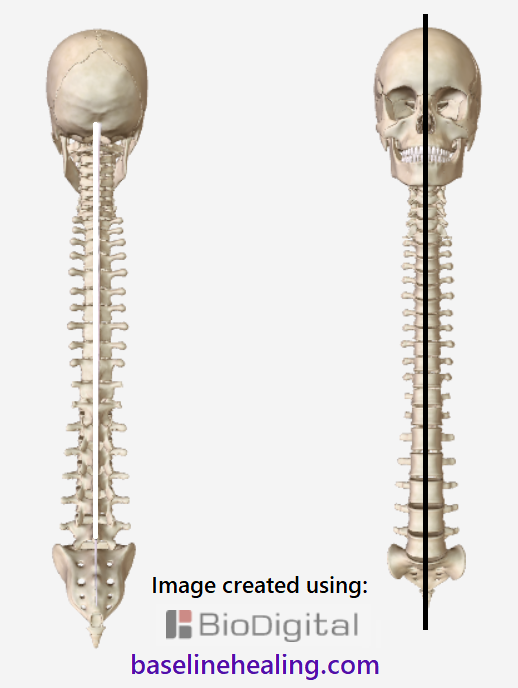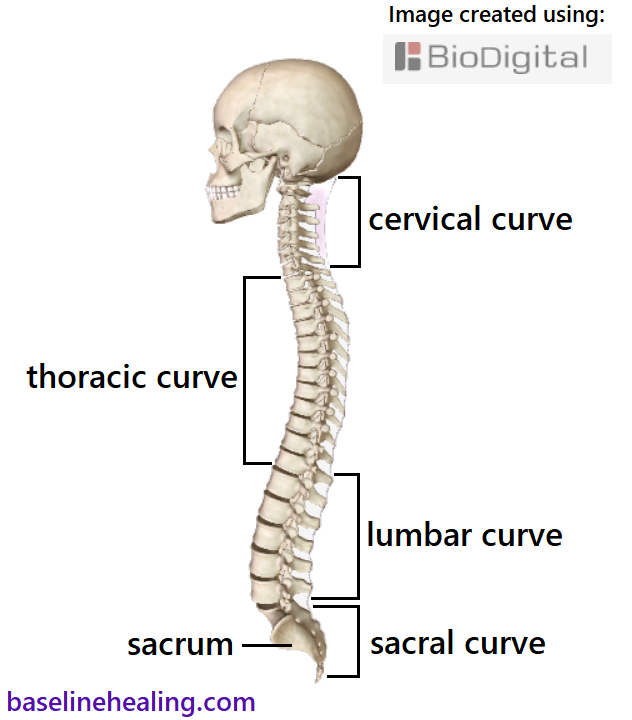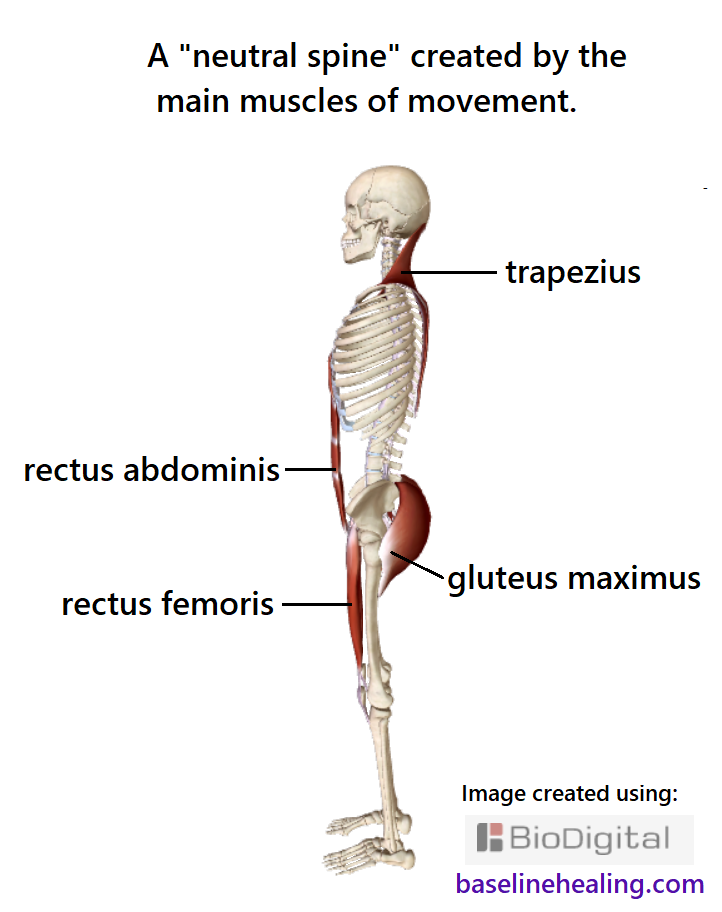A Good Posture - Muscles & Self-Awareness.
post by leggi · 2019-11-15T09:19:11.580Z · LW · GW · 3 commentsContents
Posture = The position of your body. All of it. At any time. Current presentations of posture. Base-Line Theory Health and Movement. Part 3: The muscles to focus on for a better posture, a full range of natural movement and a body that is dynamically aligned and balanced are the five main muscles of movement. Try it. Feel for yourself. Self-Assessment of Posture. Body Alignment & Midline Anatomy. Core Muscles. A neutral spine. Lying in bed trying to 'align my spine, hips and shoulders' in an attempt to improve my posture and ease the pain but I had no inner reference to guide me - until I found my Base-Line. Dynamic Posture - Movement. Definitions for Base-Line Theory: Ideal Posture. A Functional Posture. Anticipatory Posture. Positions & Poses. A Generalised Position. A Named Pose. A Full Assessment of Positioning. Final Thoughts. Muscles do the work. Muscles create our posture. Muscles can be under our conscious control. Want to 'center yourself ' and experience a sense of enlightenment? Find your Base-Line. None 3 comments
(A version appears here: What is a good posture?)
Posture = The position of your body.
All of it.
At any time.
A good posture contributes to proper functioning of our living machine.
With a good posture the body is well-positioned and comfortable. A bad posture means the body is in a less than ideal position, increasing physical stresses and resulting in pain.
But what is a "good" position for your body to be in? What is a good posture?
Current presentations of posture.
A go-ogle search for "good posture" returns various definitions:
Standing up tall. No slouching when sitting.
Positioning of the head and joints ...
Correct curvature of a neutral spine ...
Alignment of various parts of the body ...
And a lot of side-view illustrations:

Postural assessment tends to rely on external assessment (somebody else judging your position), employing:
- Visual inspection (+/- plumb-lines and grids).
- Palpation of anatomical landmarks.
- Newer techniques include radiography, photography.
Traditionally the subject is stationary or doing specific actions e.g. leaning forward/back/side to side - part of a "routine exam" of posture.
Computerised assessment of the body in motion - "gait analysis" etc. offers increased detail - but all methods tend to focus is on the positioning of bones and joints [LW · GW] (especially the spine).
But what positions our bones and joints? What moves the body? What creates our posture?
(BLTH Part 1 [LW · GW], 2, [LW · GW] [LW · GW]4, [LW · GW] [LW · GW] 5 [LW · GW])
Base-Line Theory Health and Movement. Part 3:
- Muscles and connective tissues are responsible for the relative positioning of our bones.
- Muscles and connective tissues create our posture.
Posture can be:
- Passive:
- The default setting.
- The position of your body when you are not thinking about it.
- The maintenance of a 'functional posture' (see below) at the subconscious level.
- Active:
- Conscious thought about "how you are holding yourself".
- Using voluntary muscles [LW · GW] under voluntary control to alter your positioning.
The body is dynamic - our posture is continually changing on some level.
Good postural habits can be formed by working with the right muscles for a sufficient length of time. i.e. An active posture becomes the passive norm when the relevant connections between mind and muscles have been 'wired in'.
Restrictions in the body's connective tissues reduce range of movement and add to poor posture. These restrictions can be released through movement when working with the right muscles.
But what muscles to focus on? A go-ogle for "posture muscles" names a lot of different muscles - too long a list for me to work through here (I'm happy to discuss specific muscles in comments) but nowhere gets it 'right' as far as I can see. According to my Base-Line theory of human health and movement:
The muscles to focus on for a better posture, a full range of natural movement [LW · GW] and a body that is dynamically aligned and balanced [LW · GW] are the five main muscles of movement [LW · GW].

These muscles (when fully utilised and the body is free of physical restrictions in connective tissues) create a "good posture" - whatever position the body is in, for whatever it is doing.
Our 'Base-Line' muscles (pelvic floor 'Base', rectus abdominis 'Line') are the primary muscles to focus on. The core support from where the rest of the body extends and from where movement should originate.

- 5 main muscles made easy - [LW · GW] introduction to the anatomy.
- Base-Line Breathing Technique [LW · GW]- how to find your Base-Line.
Properly utilising the main muscles of movement [LW · GW] brings an understanding of what a good posture feels like. When the body is dynamically balanced and aligned with a full range of natural movement [LW · GW]. Easy, comfortable, relaxed, strong.
Try it. Feel for yourself.
Self-Assessment of Posture.
The body provides more sensory feedback about its positioning than can ever be supplied by external sources. Becoming aware of this sensory feedback is the basis of conscious proprioception [LW · GW] (increased awareness of your sense of position, motion and balance). Connecting with your 'Base-Line' develops this connection between body and mind, bringing the benefits of:
- Increased awareness your body's positioning.
- Self-assessment of posture.
- Instinctively sensing how to move to improve positioning and work towards full range natural movement.
- Feeling for the body's state of balance and alignment.
Micro-adjustments in positioning can have wide effects throughout the body (everything's connected) which can be felt when the body-mind connection is strong.
A good posture allows the body to be in alignment and balanced.
Body Alignment & Midline Anatomy.
Body alignment comes when our midline anatomy [LW · GW] can be correctly arranged to create the median plane [LW · GW].

Linear midline structures:
- linea alba [LW · GW]. (between the rectus abdominis muscles)
- nuchal/supraspinous ligaments [LW · GW] (between the trapezius muscles)


A good posture - when the main muscles of movement support the body and our midline anatomy can be aligned on the median plane. We can stand upright with ease, with no excess strain on the spine (see below for details on a 'neutral spine'). Movement is easy and unrestricted.
Core Muscles.
"Use your core" is oft-repeated advice - but what does it really mean?
"Core muscles" has many definitions and it would not be helpful to add to this over-used term - but think of your Base-Line as your core pillar of strength.

A neutral spine.
A neutral spine is when the spine is in a natural position, under the minimal amount of stress. All vertebrae are positioned with the correct curvature and can be aligned on the median plane [LW · GW].

When seen from the front or back all vertebrae in a neutral spine appear completely vertical i.e. they are aligned.
The nuchal and supraspinous ligaments [LW · GW] that attach to the posterior (back) of the spine are also aligned.
From a side view, a neutral spine is curved.

Side view of a neutral spine:
- The cervical (neck) spine is curves inward.
- The thoracic (upper back) spine curves outwards.
- The lumbar (lower back) spine curves inward.
- The sacrum curves outwards.
For a neutral spine, the rectus abdominis [LW · GW] muscles need to be "long and strong", fully extended and taking the strain between pelvis and chest.

If the rectus abdominis muscles are not fully utilised the lateral abdominal, psoas and other muscles of the lower back bear the burden which has negative effects on the positioning of the lumbar spine and causes a lot of pain over time.
The gluteus maximus [LW · GW] positions the sacrum, linking the base of the spine to the pelvis.
The trapezius [LW · GW] muscles must be free of physical restrictions to allow the correct positioning of the thoracic and cervical spine.
Lying in bed trying to 'align my spine, hips and shoulders' in an attempt to improve my posture and ease the pain but I had no inner reference to guide me - until I found my Base-Line.
Dynamic Posture - Movement.
Posture isn't static. We are constantly on the move.
- Explore movement extending out from your Base-Line.
- Feel where the main muscles of movement are in relation to each other.
- Sense where your natural range of movement should take, you guided by your sense of proprioception [LW · GW].
- Work towards balancing and aligning your body for the ideal posture (see below)
- - --
Definitions for Base-Line Theory:
Ideal Posture.
In an ideal posture stresses are distributed and dissipated in the best/safest/most efficient possible manner for the activity being undertaken, permitting dynamic stability through a full range of natural movement [LW · GW].
An ideal posture provides the maximum capacity to deal with external stresses - the body is as strong as it can be.
There are many disciplines that appear to represent ideal postures, demonstrations of the body's capabilities when it is functioning at optimal [LW · GW]. (Caveat - I can name a few, but have little formal knowledge and no experience in most.)
For example:
- The asanas of yoga - snapshots of the body with a full range of natural movement. Named poses (see below) that can be perfected when the body is truly balanced.
- Pilates, tai chi and other internal martial arts, ballet - demonstrating the grace and freedom of movement possible with dynamic alignment.
An ideal posture is not possible if there is:
- inadequate usage of the 5 main muscles of movement.
- physical restrictions [LW · GW] reducing range of movement.
A Functional Posture.
A 'functional posture' is what the brain/body uses day-to-day when an ideal posture cannot be achieved. Subconscious adjustments are made throughout the body - twists, kinks, tilts and compressions - as the brain sees fit to keep us going - the development of a "bad posture".
A functional posture at its most basic:
- Keeps our eyes level (maintaining horizontal equilibrium in visual input).
- Keeps us facing/moving forward.
- Puts the body in a position to do the task at hand.
- Adjusts body position to bear external stresses as they are applied.
The 'wrong muscles [LW · GW]' are used to attempt to compensate for misusage in the main muscles but the body is imbalanced. myalgia of imbalance [LW · GW].
Anticipatory Posture.
When faced with a task, the body/brain prepares by activating muscles into an 'anticipatory posture' - bracing yourself.
An anticipatory posture should be the ideal posture for the activity - using the main muscles of movement to their full potential, but if that is not achievable, the body braces into a functional posture with the use of other muscles.
Becoming aware of anticipatory postures and the activation of other muscles allows self-correction by focusing on engaging with the main muscles of movement instead, over-writing bad postural habits that have developed.
Positions & Poses.
When talking about the position of the body there is a sliding scale of preciseness, from a very generalised description (which may include some details), to named poses, to a full assessment, to the constantly changing exact position.
A Generalised Position.
A generalised position may be a broad categorisation e.g. sitting, standing, squatting, or more specific e.g. sitting on hands, standing on one leg (which leg?), squatting with arms extended (extended in what direction?).
There is a wide scope for variance in the same generalised position.
A Named Pose.
e.g. downward dog, half lotus, plank pose ....
Named poses can also be considered as generalised since there is a wide range of possibilities to be in what, without closer examination, appears to be the same named pose.
Named poses are representations of the ideal, something to aim for and achievable when the body is functioning at optimal [LW · GW].
A Full Assessment of Positioning.
A full assessment considers the positioning of all parts of the body from core to extremities, looking at the details from head to fingers to toes.
A full assessment needs a starting reference - a Base-Line [LW · GW] - from where the rest of the body is positioned relative to.

Exact Position.
The body is always moving. Infinite possibilities ... Never the same position twice?
The movements of breathing, vibrations in the cardiovascular system, muscle activity etc. means the body's exact position changes moment by moment even when trying to be still. Stillness is finding the perfect oscillation for equilibrium.
On what scale is exact position considered? Movement at the cellular level - a twitch of a muscle fibre [LW · GW]? At the electro-chemical level - movement of molecules and ions? Unimportant to my theory, but something to think about.
Final Thoughts.
Muscles do the work. Muscles create our posture. Muscles can be under our conscious control.
You want to stand up straight? Use your main muscles of movement.
You want to sit properly? Use your rectus abdominis muscles to support you.
You want to know what body alignment feels like? Work towards aligning the linea alba and nuchal/supraspinous ligaments.
Want to 'center yourself ' and experience a sense of enlightenment?
Find your Base-Line.
3 comments
Comments sorted by top scores.
comment by ryan_b · 2019-12-06T16:09:58.381Z · LW(p) · GW(p)
I can vouch for sudden and significant gains in comfort and functionality by focusing on improving your posture. The method I used was less thorough than here - instead I just used an exercise band and a few stretching exercises to improve the shoulder position. This provided improved comfort immediately, and significant reduction in the fragility of my back in a matter of days.
Replies from: leggicomment by Alex Vermillion (tomcatfish) · 2021-12-26T23:41:17.596Z · LW(p) · GW(p)
Typo?
"Increased awareness your body’s positioning." -> "awareness of"